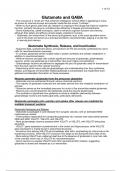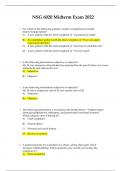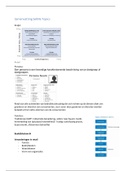Glutamate and GABA
- The concept of a "smart pill" that enhances intelligence without e ort is appealing to many,
as shown by informal surveys and popular media like the movie "Limitless."
- While no such genius pills exist yet, research is ongoing to nd drugs that improve cognitive
function, primarily focusing on conditions like Alzheimer's disease and schizophrenia.
- Some substances, called nootropics, claim to enhance cognitive function and memory,
although their safety and e cacy remain largely untested in humans.
- Glutamate, the ionized form of the amino acid glutamic acid, is the most abundant amino
acid in the brain and serves as a principal excitatory neurotransmitter, playing a crucial role
in learning and memory.
Glutamate Synthesis, Release, and Inactivation
- Dopamine (DA), acetylcholine (ACh), and serotonin (5-HT) are primarily synthesized by nerve
cells for neurotransmission purposes.
- In contrast, glutamate serves multiple roles in protein synthesis and cellular metabolism in
addition to neurotransmission.
- While all neurons and glial cells contain signi cant amounts of glutamate, glutamatergic
neurons, which use glutamate as a transmitter, have even higher concentrations.
- Glutamatergic neurons are believed to segregate the pool of glutamate used for transmission
from the pool used for other cellular functions.
- Determining which nerve cells are glutamatergic and understanding how they synthesize,
release, and dispose of transmitter-related glutamate is complicated, but researchers have
gathered considerable information on these processes.
Neurons generate glutamate from the precursor glutamine
- Glutamate can be synthesized through various chemical reactions.
- The majority of glutamate molecules are ultimately derived from the metabolic breakdown of
glucose.
- Glutamine serves as the immediate precursor for much of the transmitter-related glutamate.
- Neurons can convert glutamine into glutamate using the enzyme glutaminase.
- The synthesis of glutamate from glutamine involves a metabolic partnership between
glutamatergic neurons and nearby glial cells, particularly astrocytes.
Glutamate packaging into vesicles and uptake after release are mediated by
multiple transport systems
Glutamate Packaging and Release
- Glutamate is packaged in and released from synaptic vesicles, with an estimated 8000
molecules per vesicle.
- Three proteins responsible for transporting glutamate into vesicles were discovered between
2000 and 2002: VGLUT1, VGLUT2, and VGLUT3.
- Most glutamatergic neurons possess either VGLUT1 or VGLUT2, with VGLUT3 being less
abundant.
- VGLUT1 gene expression is predominant in the cortex and hippocampus, while VGLUT2
gene expression is mostly found in subcortical structures.
- Knockout mice lacking VGLUT2 die immediately after birth, emphasizing its critical role in life-
sustaining functions, while VGLUT1 knockout mice begin to die during the third week of life.
- Mice lacking VGLUT3 are viable but deaf due to the absence of glutamate in inner hair cells
of the cochlea, which rely on VGLUT3 for neurotransmission.
- Some neurons co-express VGLUT3 and other neurotransmitter markers, suggesting
glutamate is stored and released as a co-transmitter.
ffi fi fi ff
, 2 of 13
- Neurons exhibiting co-expression of vesicular transporters may segregate their vesicles or
axon terminals to release di erent neurotransmitters at separate sites.
- Further research is needed to understand the mechanisms and functional signi cance of
glutamate as a co-transmitter with other classical neurotransmitters like dopamine, serotonin,
acetylcholine, GABA, and glycine.
Glutamate Uptake After Release
- Glutamate molecules, once released into the extracellular space, are rapidly removed by
glutamate transporters on cell membranes.
- Plasma membrane transporters responsible for removing neurotransmitters from the
extracellular space are distinct from vesicle membrane transporters responsible for loading
vesicles in preparation for transmitter release.
- Five di erent plasma membrane transporters have been identi ed for glutamate uptake,
known as excitatory amino acid transporters (EAATs), including EAAT1 to EAAT5.
- Astrocytes play a crucial role in taking up glutamate after its release, particularly through the
expression of EAAT2, which accounts for about 90% of total glutamate uptake in the brain.
- Knockout mice lacking EAAT2 exhibit spontaneous epileptic seizures, increased susceptibility
to induced seizures and brain injury, and shortened lifespans.
- The metabolic partnership between neurons and astrocytes involves the conversion of
glutamate to glutamine by astrocytes using the enzyme glutamine synthetase.
- Glutamine produced by astrocytes is then transported to neurons, where it can be converted
back into glutamate.
- Glutamine synthetase also aids in the metabolism and removal of ammonia, which can have
adverse e ects if not properly managed.
- Knockout mice lacking glutamine synthetase gene die before birth, and humans with
congenitally reduced glutamine synthetase activity experience brain deformities, seizures, and
shortened lifespans.
Organization and Function of the Glutamatergic System
- Glutamate functions as the main neurotransmitter for fast excitatory signaling in the nervous
system.
- It is involved in numerous excitatory neuronal pathways and primarily activates ionotropic
receptors that elicit rapid postsynaptic responses.
- Although a detailed examination of all glutamatergic pathways is not feasible here, several
extensively studied pathways exist.
- The glutamatergic system plays essential roles in both health and disease states, contributing
to various neurological functions and disorders.
Glutamate is the neurotransmitter used in many excitatory pathways in the brain
- Glutamate serves as the primary neurotransmitter used by pyramidal neurons in the cerebral
cortex, which are the major output neurons of the cortex and project to various subcortical
structures.
- It is also utilized by the parallel bers of the cerebellar cortex and several excitatory pathways
within the hippocampus.
- Due to its widespread presence throughout the brain, assigning speci c functional roles to
glutamate is challenging compared to other neurotransmitters.
- Glutamate is implicated in numerous behavioral and physiological functions under normal and
abnormal conditions, including synaptic plasticity, learning and memory, neuronal cell death in
neurological disorders, and potentially the development of psychopathological disorders such
as drug addiction and schizophrenia.
ff ff ff fi fi fi fi











